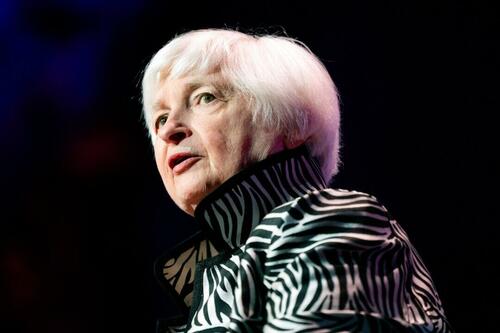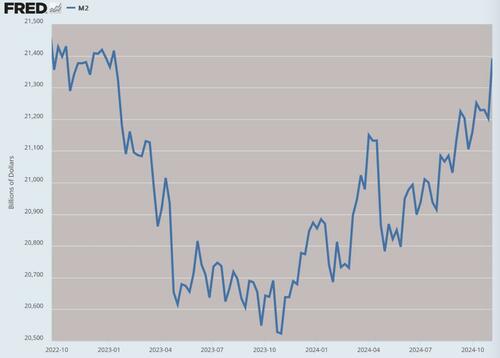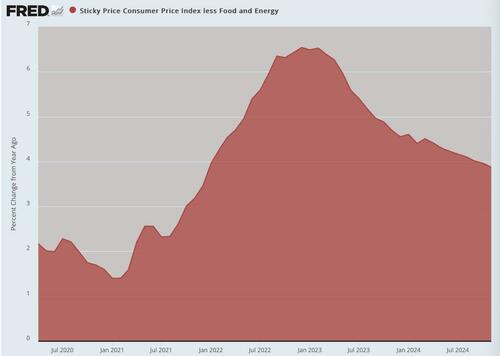Some Honesty About Inflation
Authored by Jeffrey Tucker via The Epoch Times,
Inflation numbers came out last week. For once, we got some honesty from the mainstream media.
“Growing inflation poses challenges for the Fed,” said the WSJ.
“Progress on inflation stalled, complicating Republicans’ plans,” said the NYT.
That’s a major change in the tune from “it’s just transitory.”
That was Janet Yellen, four years ago!
It was a grim number, an annualized increase of 2.7 percent, which is still far over the target rate.
Those of us who watch real-time numbers knew it was coming. We’ve seen a heating up for three months. Right now, those numbers are showing a 3 percent rate of annualized inflation.
It’s been a four-year trend now toward ever higher prices, resulting in a dramatic loss of purchasing power in terms of goods and services. In this time, the dollar has lost a minimum of 25 cents of value or as much as double and triple that depending on the purchase. The result has been a loss of real income, hitting the working class and poor the hardest.
At last we are getting some honesty, probably now that it is a problem that Trump will inherit. Plenty of people out there are happy about this and have hopes that the problem with vex him as it did Biden.
We did not hear this on the campaign trail but there is not much a president can do about inflation in the short term. The usual lag between cause and effect on inflation is 12 to 18 months.
Unplugging the money-printing machine is a fix down the line. But in the short term, it has a potentially deleterious effect on macroeconomic stability that can result in obvious recession. And right now, we see all the signs of a reacceleration taking place.
The money stock as measured by M2 bottomed out in October 2023 but has since increased by $1.9 trillion. That’s a dramatic turn that only adds fuel to the inflationary fire. It’s not just the deliberate policy to loosen up via interest rate cuts but also a change in velocity combined with more bank lending. None of it looks good for stabilizing the dollar in terms of domestic purchases.
(Data: Federal Reserve Economic Data (FRED), St. Louis Fed; Chart: Jeffrey A. Tucker)
The sticky price index has never shown much in the way of victory over the worst inflation in nearly half a century. Certainly there has never been a reason to relax, much less change posture from a restrictive policy to a more liberal one. It currently stands at 3.9 percent, which is nearly double the target rate. That’s an incredibly bad rate of inflation to start a new presidential term.
(Data: Federal Reserve Economic Data (FRED), St. Louis Fed; Chart: Jeffrey A. Tucker)
That the central bank is primarily responsible for inflation is not unknown. The trouble with putting an end to it—which would actually be very easy—is mainly a political one. Every president wants lower interest rates in order to drive national output. They don’t like a central bank policy that is restrained with higher rates. So they typically push for lower rates.
Lower rates create conditions for more credit expansion and that adds to the money stock and fuels inflationary pressure for which the president is held responsible. However, he is also held responsible for recessions. That creates a terrible dilemma for an incoming administration that had made two grand promises: to boost economic growth and end inflation.
Absent huge structural changes in regulation and spending, it is not likely both can happen at once.
When this dilemma confronted Ronald Reagan upon taking office in 1981, the answer was to endure a recession for 18-24 months to create the conditions for future economic growth. But it was a true war against the clock, with a huge scramble to boost growth while stopping inflation. They didn’t quite make it in time and lost substantially in the midterm elections of 1982. The recovery finally arrived in time for Reagan to win a second term.
In those days, officials were much more honest with the public. It was frankly admitted that a recession was a necessary condition for renewed growth. But it has been 40 years since anyone in a position of official influence has said anything remotely like that.
We have an added problem now that full recovery from the economic calamity of 2020 has never really happened. Job openings soared after reopening but those days are over, and we’ve been on a two-year slide. Moreover, the Philadelphia Fed is dropping some truth about jobs numbers from earlier this year. To summarize: they were fake.
Looking back at output numbers with a realistic estimate of inflation reduces GDP growth in real terms to recessionary levels, though it has not been widely admitted.
Where does that put the incoming Trump administration in relation to Fed policy? It’s a genuine dilemma. Despite all the pretenses from the top that the Fed is using informed science and access to granulated data to guide its decision-making, the reality is that Fed chairman Jerome Powell has no idea what to do now. He can continue the rate-cutting and reignite inflation or freeze rates now and risk the ire of the incoming administration.
Regional presidents of Federal Reserve banks around the country are divided on what should happen. It’s a balancing act because the labor market is weak and getting worse even as inflation is worsening too. Typically, the old models on which they used to rely posited that labor markets operate in an inverse relationship with price pressure. That pattern is not part of the present reality.
One possibility is that dramatic spending cuts of the federal budget could dampen inflationary pressure. That is because a reduced rate of debt creation takes pressure off the Federal Reserve to enter the bond market to support dollar-denominated debt. Part of the job of the Department of Government Efficiency (DOGE), which is not an official agency, is to create public support for dramatic spending cuts.
Maybe that works but will it be enough? Cutting $2 trillion out of the federal budget might sound easy but nothing like this has happened in a century of government policy. Is the public sufficiently alarmed about a fiscal crisis that it can endure extreme cuts in public services?
There is no way that cuts on that level will not be felt. The Washington bureaucracies backed by the press will scream about impending disaster, starving widows and orphans, slowed down passports, cuts in staff at monuments and federal parks, and all the other usual tropes. DOGE will need to be prepared to call out all the propaganda as nothing but flimflam designed to preserve the status quo.
What we really need is a return to honesty in economics, along with an admission that we cannot defeat the inflation we despise without a period of pain. I’m aware that no one likes to speak this way and that the political culture is hyper-intolerant toward long-term solutions. The expectations for the incoming Trump administration is that it will deploy some magic cure to lower real incomes, deep indebtedness, and a failing job market. Nothing like that exists.
Economics is about wealth creation but it is also about accounting. Optimism and political exuberance are wonderful but they cannot substitute for hard choices. And that includes some measure of pain before we can get on track toward renewed economic growth. That is a lesson that the incoming Trump administration can learn from Reagan’s experience in 1981.
* * *
Views expressed in this article are opinions of the author and do not necessarily reflect the views of The Epoch Times or ZeroHedge.
Tyler Durden
Tue, 12/17/2024 – 14:25



